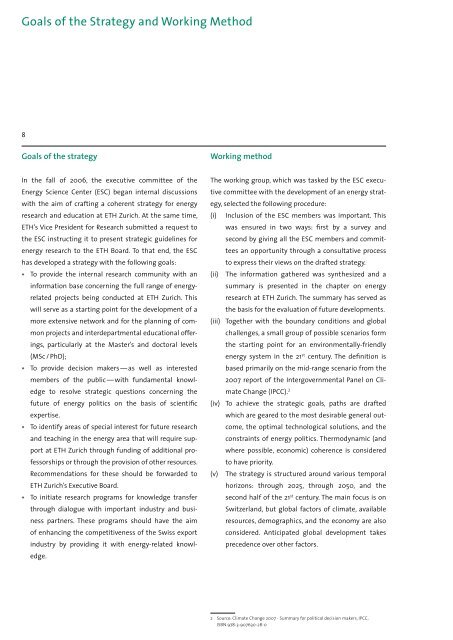Energy Strategy for ETH Zurich
Energy Strategy for ETH Zurich
Energy Strategy for ETH Zurich
You also want an ePaper? Increase the reach of your titles
YUMPU automatically turns print PDFs into web optimized ePapers that Google loves.
Goals of the <strong>Strategy</strong> and Working Method<br />
8<br />
Goals of the strategy<br />
In the fall of 2006, the executive committee of the<br />
<strong>Energy</strong> Science Center (ESC) began internal discussions<br />
with the aim of crafting a coherent strategy <strong>for</strong> energy<br />
research and education at <strong>ETH</strong> <strong>Zurich</strong>. At the same time,<br />
<strong>ETH</strong>’s Vice President <strong>for</strong> Research submitted a request to<br />
the ESC instructing it to present strategic guidelines <strong>for</strong><br />
energy research to the <strong>ETH</strong> Board. To that end, the ESC<br />
has developed a strategy with the following goals:<br />
• To provide the internal research community with an<br />
•<br />
•<br />
•<br />
in<strong>for</strong>mation base concerning the full range of energyrelated<br />
projects being conducted at <strong>ETH</strong> <strong>Zurich</strong>. This<br />
will serve as a starting point <strong>for</strong> the development of a<br />
more extensive network and <strong>for</strong> the planning of common<br />
projects and interdepartmental educational offerings,<br />
particularly at the Master’s and doctoral levels<br />
(MSc / PhD);<br />
To provide decision makers — as well as interested<br />
mem bers of the public — with fundamental knowl-<br />
edge to resolve strategic questions concerning the<br />
future of energy politics on the basis of scientific<br />
expertise.<br />
To identify areas of special interest <strong>for</strong> future research<br />
and teaching in the energy area that will require support<br />
at <strong>ETH</strong> <strong>Zurich</strong> through funding of additional professorships<br />
or through the provision of other resources.<br />
Recommendations <strong>for</strong> these should be <strong>for</strong>warded to<br />
<strong>ETH</strong> <strong>Zurich</strong>’s Executive Board.<br />
To initiate research programs <strong>for</strong> knowledge transfer<br />
through dialogue with important industry and business<br />
partners. These programs should have the aim<br />
of enhancing the competitiveness of the Swiss export<br />
industry by providing it with energy-related knowledge.<br />
Working method<br />
The working group, which was tasked by the ESC executive<br />
committee with the development of an energy strategy,<br />
selected the following procedure:<br />
(i) Inclusion of the ESC members was important. This<br />
was ensured in two ways: first by a survey and<br />
second by giving all the ESC members and committees<br />
an opportunity through a consultative process<br />
to express their views on the drafted strategy.<br />
(ii) The in<strong>for</strong>mation gathered was synthesized and a<br />
summary is presented in the chapter on energy<br />
research at <strong>ETH</strong> <strong>Zurich</strong>. The summary has served as<br />
the basis <strong>for</strong> the evaluation of future developments.<br />
(iii) Together with the boundary conditions and global<br />
challenges, a small group of possible scenarios <strong>for</strong>m<br />
the starting point <strong>for</strong> an environmentally-friendly<br />
energy system in the 21st century. The definition is<br />
based primarily on the mid-range scenario from the<br />
2007 report of the Intergovernmental Panel on Climate<br />
Change (IPCC). 2<br />
(iv) To achieve the strategic goals, paths are drafted<br />
which are geared to the most desirable general outcome,<br />
the optimal technological solutions, and the<br />
constraints of energy politics. Thermodynamic (and<br />
where possible, economic) coherence is considered<br />
to have priority.<br />
(v) The strategy is structured around various temporal<br />
horizons: through 2025, through 2050, and the<br />
second half of the 21st century. The main focus is on<br />
Switzerland, but global factors of climate, available<br />
resources, demographics, and the economy are also<br />
considered. Anticipated global development takes<br />
precedence over other factors.<br />
2 Source: Climate Change 2007 - Summary <strong>for</strong> political decision makers, IPCC,<br />
ISBN 978-3-907630-28-0
















